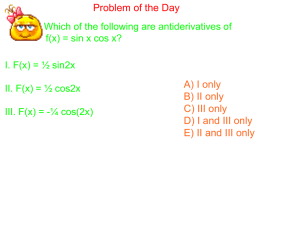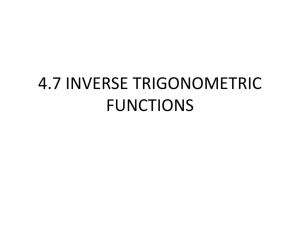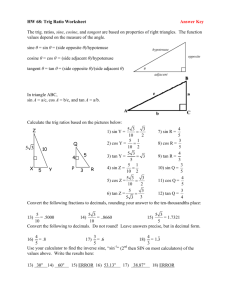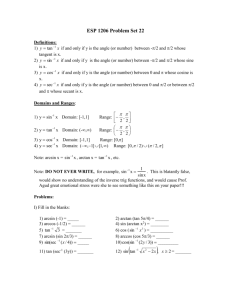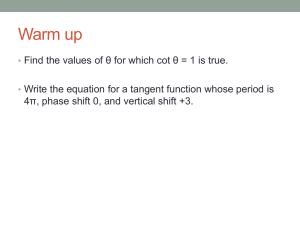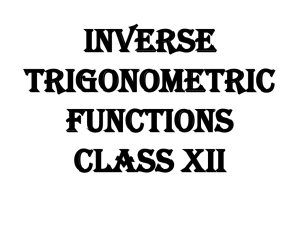Tangent Function f(x) := tanx Domain: So the domain of f(x) := tanx is
advertisement
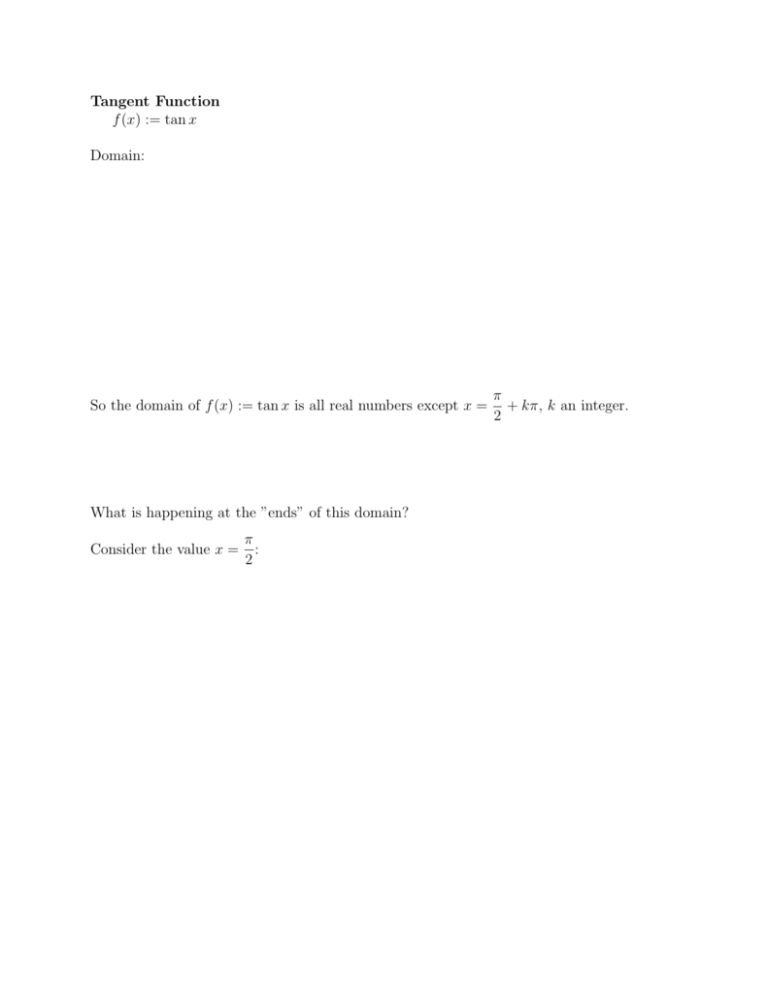
Tangent Function f (x) := tan x Domain: So the domain of f (x) := tan x is all real numbers except x = What is happening at the ”ends” of this domain? Consider the value x = π : 2 π + kπ, k an integer. 2 Similar logic can be used to show that the behavior around each of the other ”ends” of the domain 3π is the same. For example, for x = : 2 lim − tan x = ∞ and x→ 3π 2 lim + tan x = −∞ x→ 3π 2 Intercepts: Putting all of this together gives the tangent graph: y 4 2 -2 Π - 32Π -Π - Π2 Π 2 Π 3Π 2 -2 -4 Figure 1: y = tan(x) x 2Π Inverse Trig Functions All of the trig functions are periodic and thus are not one-to-one. To define the inverse trig functions, we must restrict the domain to an interval that is one-to-one. 1) Inverse Sine Function Notations: f (x) = sin−1 (x) or f (x) = arcsin(x) Consider the graph of y = sin x: 2 y 1 -2 Π - 32Π -Π - Π2 Π 2 Π 3Π 2 x 2Π -1 -2 Figure 2: y = sin(x) Clearly, the graph fails the HLT. However, we can still define an inverse function if we have a piece where: • the graph of y = sin x is 1-1 • the graph of y = sin x covers its entire range The standard interval used is h π πi − , 2 2 Definition: The inverse sine function (or arcsine function) is defined by: y = sin−1 (x) or y = arcsin(x) if an only if π π sin(y) = x AND −1 ≤ x ≤ 1, − ≤ y ≤ 2 2 Comment: The graph of y = sin−1 (x) is the reflection of the graph of y = sin x over the line y = x on the restricted domain. 2 y 1 -Π - Π2 Π 2 Π x -1 -2 Figure 3: y = sin(x) Π y Π 2 -2 -1 1 - Π2 -Π Figure 4: y = arcsin(x) x Example 1: Evaluate sin−1 √ ! 3 . 2 1 Example 2: Evaluate arcsin − √ . 2 Example 3: Is sin−1 (sin π) = π? 2) Inverse Cosine Function Notations: f (x) = cos−1 (x) or f (x) = arccos(x) 2 y 1 -2 Π - 32Π -Π - Π2 Π 2 Π 3Π 2 x 2Π -1 -2 Figure 5: y = cos(x) Again, we choose an interval where y = cos x is one-to-one and covers the entire range: [0, π] Definition: The inverse cosine function (or arccosine function) is defined by: y = cos−1 (x) or y = arccos(x) if an only if cos(y) = x AND −1 ≤ x ≤ 1, 0 ≤ y ≤ π 2 y 1 - Π2 Π 2 Π 3Π 2 x -1 -2 Figure 6: y = cos(x) 3Π 2 y Π Π 2 -2 -1 1 - Π2 Figure 7: y = arccos(x) 2 x √ ! 3 Example 4: Evaluate arccos − . 2 Example 5: Evaluate cos−1 (3). 3) Inverse Tangent Function Notations: f (x) = tan−1 (x) or f (x) = arctan(x) y 4 2 -2 Π - 32Π -Π - Π2 Π 2 Π 3Π 2 x 2Π -2 -4 Figure 8: y = tan(x) Definition: The inverse tangent function (or arctangent function) is defined by y = tan−1 (x) or y = arctan(x) if an only if π π tan(y) = x AND − < y < 2 2 Π y Π 2 -4 -2 2 4 - Π2 -Π Figure 9: y = arctan(x) x Example 6: Evaluate tan−1 (−1)
